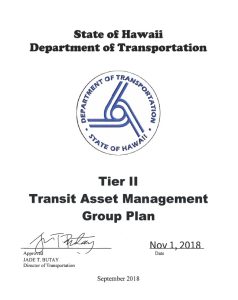Transit Asset Management (TAM) Plan
Statewide Transportation Planning Office
Transit Asset Management (TAM) Plan
Federal Transit Administration (FTA) TAM Plan
Every agency must develop a transit asset management (TAM) plan if it owns, operates, or manages capital assets used to provide public transportation and receives federal financial assistance under 49 U.S.C. Chapter 53 as a recipient or subrecipient. Each transit provider must designate an Accountable Executive (49 CFR 625.5) to ensure appropriate resources for implementing the agency’s TAM plan and the Transit Agency Safety Plan.
TAM Plan Update
Agencies are required to update their TAM plan in its entirety at least once every four years. The first compliant TAM plans were due October 2018 and agencies must complete an updated plan every four years beginning in October 2022. The TAM plan cycle should coincide, to the extent possible, with the State and metropolitan planning cycle for the development of the State Transportation Improvement Program (STIP) and Transportation Improvement Program (TIP).
TAM Plan Elements
Tier I agencies must comply with all nine elements of the TAM plan. Tier II agencies are responsible only for the top four elements.
| Tier | Element | Brief Description |
| Tier I and II | I. An inventory of asset | A register of capital assets and information about those assets. |
| 2. A condition assessment of inventoried assets | A rating of the assets’ physical state; to be completed for assets an agency has direct capital responsibility for; should be at a level of detail sufficient to monitor and predict performance of inventoried assets | |
| 3. Description of a decision support tool | An analytic process or tool that (1) assists in capital asset investment prioritization and/or (2) estimates capital needs over time does not necessarily mean software |
|
| 4. A prioritized list of investments | A prioritized list of projects or programs to manage or improve the SGR of capital assets | |
| Tier I only | 5. TAM and SGR policy | A TAM policy is the executive-level direction regarding expectations for transit asset management; a TAM strategy consists of the actions that support the implementation of the TAM policy |
| 6. Implementation strategy | The operational actions that a transit provider decides to conduct, in order to achieve its TAM goals and policies | |
| 7. List of key annual activities | The actions needed to implement a TAM plan for each year of the plan’s horizon | |
| 8. Identification of resources | A summary or list of the resources, including personnel, that a provider needs to develop and carry out the TAM plan | |
| 9. Evaluation plan | An outline of how a provider will monitor, update, and evaluate, as needed, its TAM plan and related business practices, to ensure the continuous improvement |
Group TAM Plans
Tier II agencies may develop their own plans or participate in a group TAM plan, which is compiled by a group TAM plan sponsor (generally the State DOT or a direct or designated §5310 or §5307 recipient). The purpose of the group plan option is to reduce the planning and reporting burden on smaller transit agencies from having to develop individual plans and to report to FTA’s National Transit Database (NTD) on their own. The group plan uses consolidated performance targets that apply to the group of participants as a whole, rather than to individual agencies.
Current TAM Plan
The latest version of the HDOT STP TAM Plan (2025) was completed 9/30/25 and approved 10/18/25.
CLICK HERE or click on the image above to view or download a copy.
Prior Version
The see the prior HDOT STP TAM Plan (2022), click on the image below to view or download a PDF:
CLICK HERE or click on the image above to view or download a copy.
Other Versions
To see the prior HDOT STP TAM Plan (2018), click on the image below to view or download a PDF:
CLICK HERE or click on the image above to view or download a copy.
Contact
If you have any questions or comments regarding the information on this website, please email Candi N. Jefferson ([email protected]) or call (808) 831-7988 for assistance.


